Operations and Project Management Strategies at Sainsbury's Plc
VerifiedAdded on 2023/06/07
|20
|4781
|230
Report
AI Summary
This report provides a comprehensive analysis of operations and project management within Sainsbury's Plc, the second-largest supermarket in the United Kingdom. It begins with an overview of Sainsbury's, its history, and its market position. The report reviews and critiques the implementation of operations management principles, distinguishing between operations and operations management, and evaluating how well Sainsbury's operations meet organizational requirements. It discusses continuous improvement as a philosophy, highlighting Lean principles and Six Sigma, and proposes a continuous improvement plan incorporating Kaizen, quality circles, benchmarking, TQM, SCM, ERP, and value engineering. The effectiveness of the continuous improvement plan is analyzed using benchmarking and total quality management theories. The report concludes with justified recommendations for improvement, emphasizing employee training, cost reduction, and customer-centric approaches. The analysis also touches upon project methodologies, tools, and the project life cycle, referencing Taylor's theory of Scientific Management and flexible specialization.
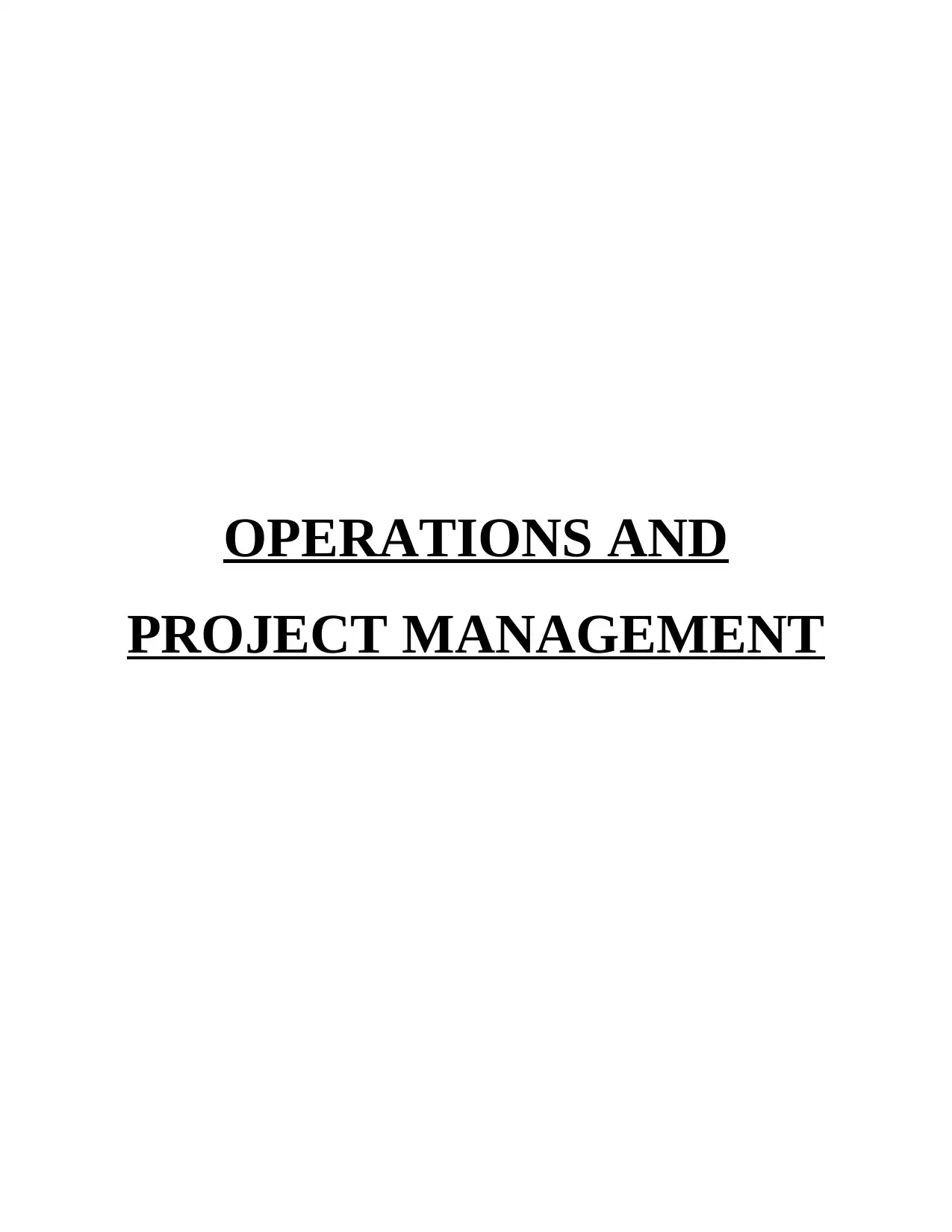
OPERATIONS AND
PROJECT MANAGEMENT
PROJECT MANAGEMENT
Paraphrase This Document
Need a fresh take? Get an instant paraphrase of this document with our AI Paraphraser
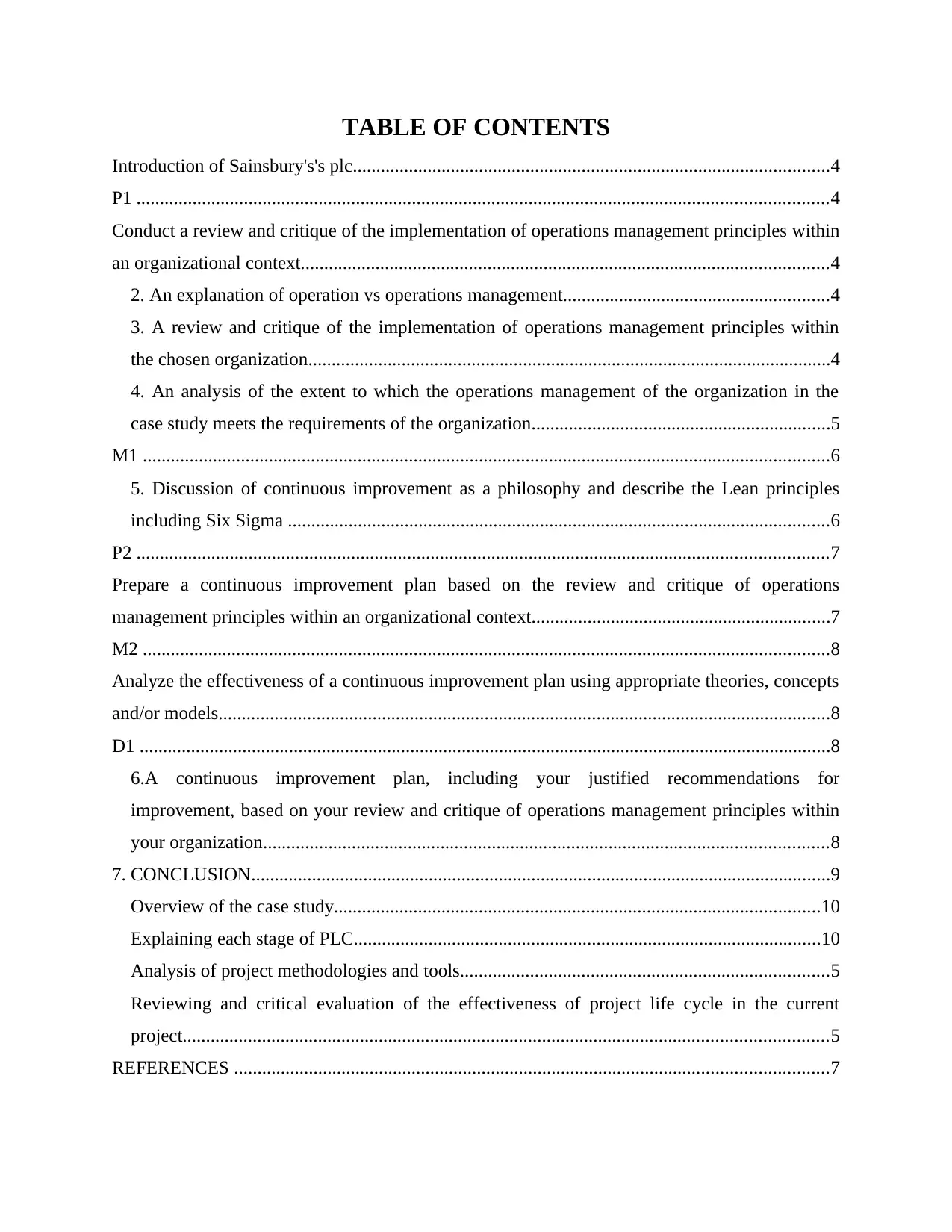
TABLE OF CONTENTS
Introduction of Sainsbury's's plc......................................................................................................4
P1 ....................................................................................................................................................4
Conduct a review and critique of the implementation of operations management principles within
an organizational context.................................................................................................................4
2. An explanation of operation vs operations management.........................................................4
3. A review and critique of the implementation of operations management principles within
the chosen organization................................................................................................................4
4. An analysis of the extent to which the operations management of the organization in the
case study meets the requirements of the organization................................................................5
M1 ...................................................................................................................................................6
5. Discussion of continuous improvement as a philosophy and describe the Lean principles
including Six Sigma ....................................................................................................................6
P2 ....................................................................................................................................................7
Prepare a continuous improvement plan based on the review and critique of operations
management principles within an organizational context................................................................7
M2 ...................................................................................................................................................8
Analyze the effectiveness of a continuous improvement plan using appropriate theories, concepts
and/or models...................................................................................................................................8
D1 ....................................................................................................................................................8
6.A continuous improvement plan, including your justified recommendations for
improvement, based on your review and critique of operations management principles within
your organization.........................................................................................................................8
7. CONCLUSION............................................................................................................................9
Overview of the case study........................................................................................................10
Explaining each stage of PLC....................................................................................................10
Analysis of project methodologies and tools...............................................................................5
Reviewing and critical evaluation of the effectiveness of project life cycle in the current
project..........................................................................................................................................5
REFERENCES ...............................................................................................................................7
Introduction of Sainsbury's's plc......................................................................................................4
P1 ....................................................................................................................................................4
Conduct a review and critique of the implementation of operations management principles within
an organizational context.................................................................................................................4
2. An explanation of operation vs operations management.........................................................4
3. A review and critique of the implementation of operations management principles within
the chosen organization................................................................................................................4
4. An analysis of the extent to which the operations management of the organization in the
case study meets the requirements of the organization................................................................5
M1 ...................................................................................................................................................6
5. Discussion of continuous improvement as a philosophy and describe the Lean principles
including Six Sigma ....................................................................................................................6
P2 ....................................................................................................................................................7
Prepare a continuous improvement plan based on the review and critique of operations
management principles within an organizational context................................................................7
M2 ...................................................................................................................................................8
Analyze the effectiveness of a continuous improvement plan using appropriate theories, concepts
and/or models...................................................................................................................................8
D1 ....................................................................................................................................................8
6.A continuous improvement plan, including your justified recommendations for
improvement, based on your review and critique of operations management principles within
your organization.........................................................................................................................8
7. CONCLUSION............................................................................................................................9
Overview of the case study........................................................................................................10
Explaining each stage of PLC....................................................................................................10
Analysis of project methodologies and tools...............................................................................5
Reviewing and critical evaluation of the effectiveness of project life cycle in the current
project..........................................................................................................................................5
REFERENCES ...............................................................................................................................7

⊘ This is a preview!⊘
Do you want full access?
Subscribe today to unlock all pages.

Trusted by 1+ million students worldwide
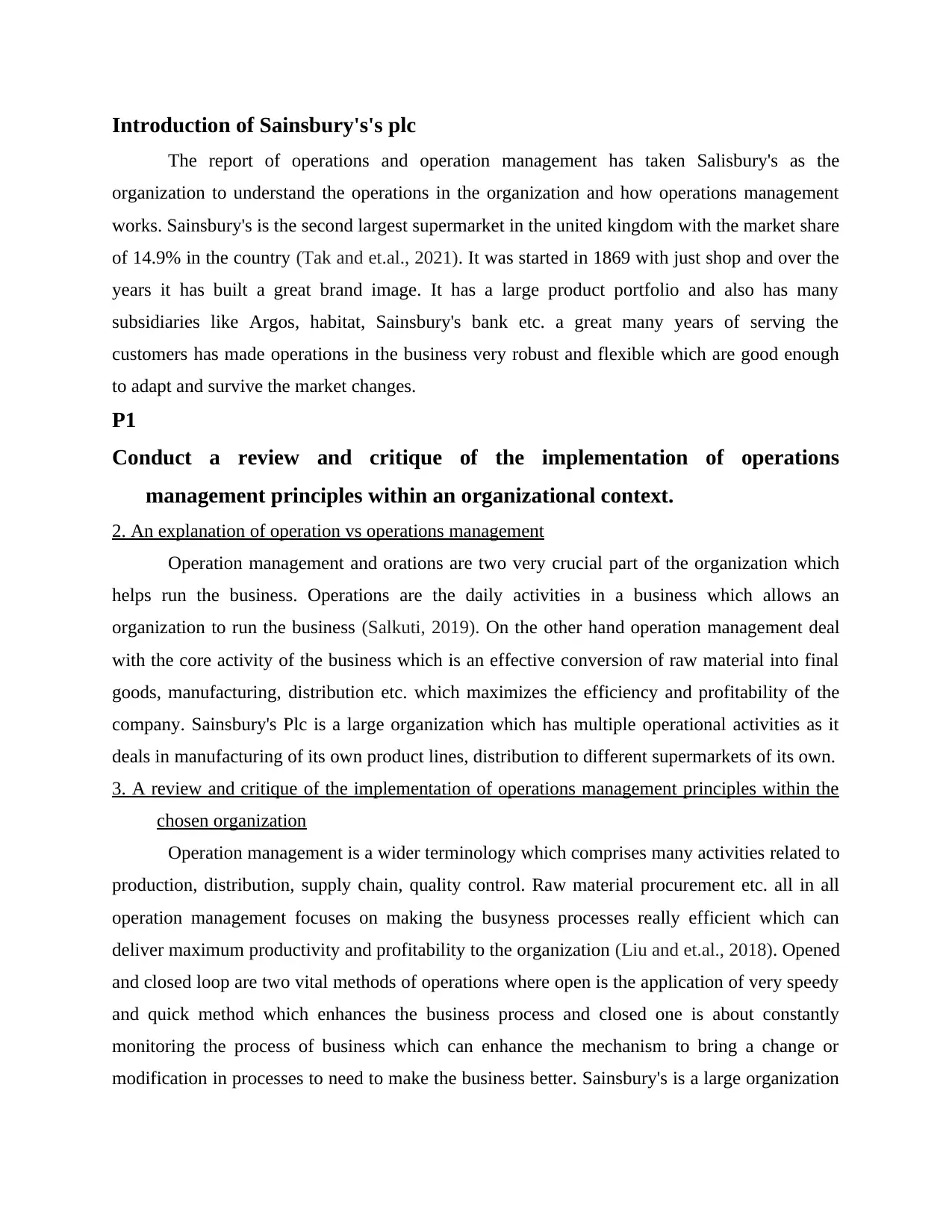
Introduction of Sainsbury's's plc
The report of operations and operation management has taken Salisbury's as the
organization to understand the operations in the organization and how operations management
works. Sainsbury's is the second largest supermarket in the united kingdom with the market share
of 14.9% in the country (Tak and et.al., 2021). It was started in 1869 with just shop and over the
years it has built a great brand image. It has a large product portfolio and also has many
subsidiaries like Argos, habitat, Sainsbury's bank etc. a great many years of serving the
customers has made operations in the business very robust and flexible which are good enough
to adapt and survive the market changes.
P1
Conduct a review and critique of the implementation of operations
management principles within an organizational context.
2. An explanation of operation vs operations management
Operation management and orations are two very crucial part of the organization which
helps run the business. Operations are the daily activities in a business which allows an
organization to run the business (Salkuti, 2019). On the other hand operation management deal
with the core activity of the business which is an effective conversion of raw material into final
goods, manufacturing, distribution etc. which maximizes the efficiency and profitability of the
company. Sainsbury's Plc is a large organization which has multiple operational activities as it
deals in manufacturing of its own product lines, distribution to different supermarkets of its own.
3. A review and critique of the implementation of operations management principles within the
chosen organization
Operation management is a wider terminology which comprises many activities related to
production, distribution, supply chain, quality control. Raw material procurement etc. all in all
operation management focuses on making the busyness processes really efficient which can
deliver maximum productivity and profitability to the organization (Liu and et.al., 2018). Opened
and closed loop are two vital methods of operations where open is the application of very speedy
and quick method which enhances the business process and closed one is about constantly
monitoring the process of business which can enhance the mechanism to bring a change or
modification in processes to need to make the business better. Sainsbury's is a large organization
The report of operations and operation management has taken Salisbury's as the
organization to understand the operations in the organization and how operations management
works. Sainsbury's is the second largest supermarket in the united kingdom with the market share
of 14.9% in the country (Tak and et.al., 2021). It was started in 1869 with just shop and over the
years it has built a great brand image. It has a large product portfolio and also has many
subsidiaries like Argos, habitat, Sainsbury's bank etc. a great many years of serving the
customers has made operations in the business very robust and flexible which are good enough
to adapt and survive the market changes.
P1
Conduct a review and critique of the implementation of operations
management principles within an organizational context.
2. An explanation of operation vs operations management
Operation management and orations are two very crucial part of the organization which
helps run the business. Operations are the daily activities in a business which allows an
organization to run the business (Salkuti, 2019). On the other hand operation management deal
with the core activity of the business which is an effective conversion of raw material into final
goods, manufacturing, distribution etc. which maximizes the efficiency and profitability of the
company. Sainsbury's Plc is a large organization which has multiple operational activities as it
deals in manufacturing of its own product lines, distribution to different supermarkets of its own.
3. A review and critique of the implementation of operations management principles within the
chosen organization
Operation management is a wider terminology which comprises many activities related to
production, distribution, supply chain, quality control. Raw material procurement etc. all in all
operation management focuses on making the busyness processes really efficient which can
deliver maximum productivity and profitability to the organization (Liu and et.al., 2018). Opened
and closed loop are two vital methods of operations where open is the application of very speedy
and quick method which enhances the business process and closed one is about constantly
monitoring the process of business which can enhance the mechanism to bring a change or
modification in processes to need to make the business better. Sainsbury's is a large organization
Paraphrase This Document
Need a fresh take? Get an instant paraphrase of this document with our AI Paraphraser
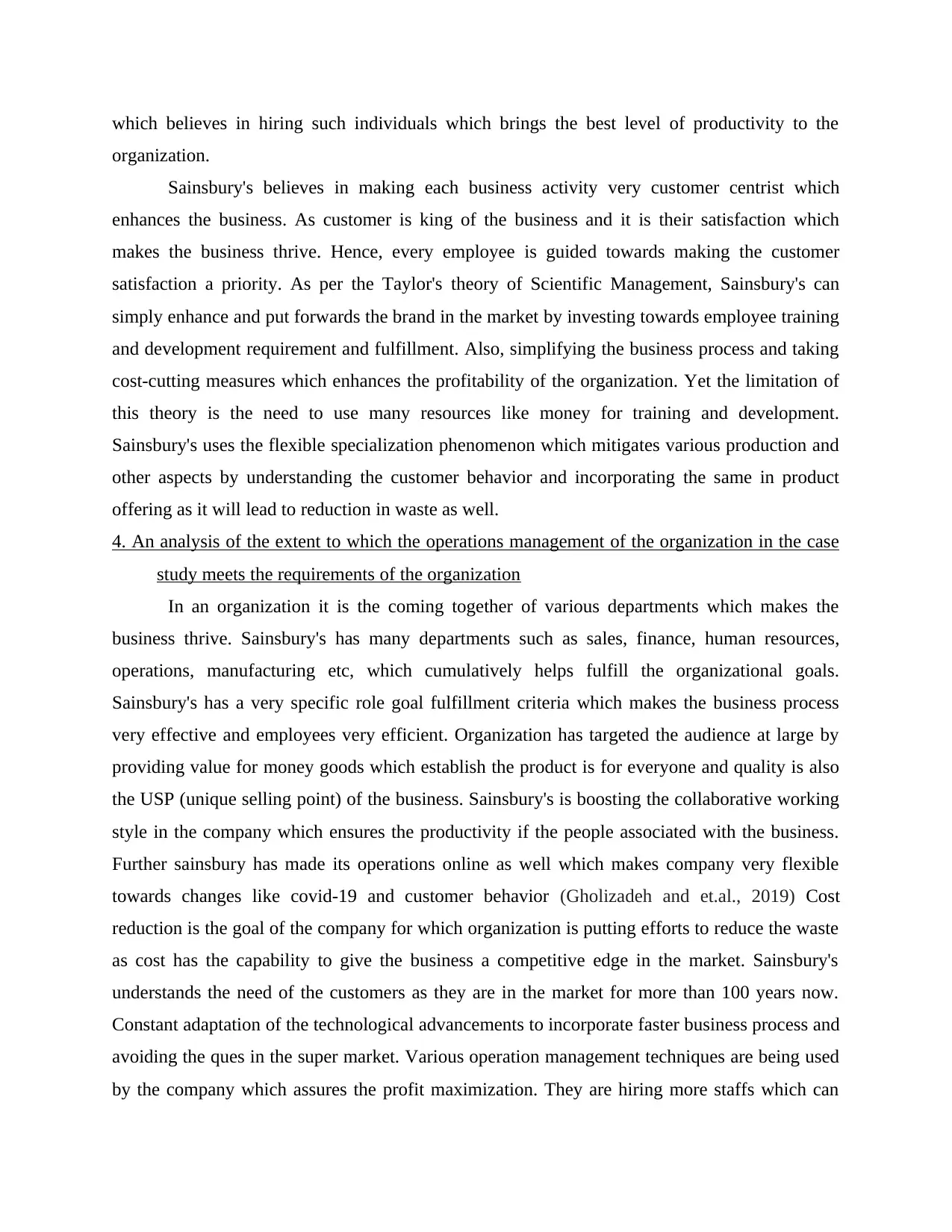
which believes in hiring such individuals which brings the best level of productivity to the
organization.
Sainsbury's believes in making each business activity very customer centrist which
enhances the business. As customer is king of the business and it is their satisfaction which
makes the business thrive. Hence, every employee is guided towards making the customer
satisfaction a priority. As per the Taylor's theory of Scientific Management, Sainsbury's can
simply enhance and put forwards the brand in the market by investing towards employee training
and development requirement and fulfillment. Also, simplifying the business process and taking
cost-cutting measures which enhances the profitability of the organization. Yet the limitation of
this theory is the need to use many resources like money for training and development.
Sainsbury's uses the flexible specialization phenomenon which mitigates various production and
other aspects by understanding the customer behavior and incorporating the same in product
offering as it will lead to reduction in waste as well.
4. An analysis of the extent to which the operations management of the organization in the case
study meets the requirements of the organization
In an organization it is the coming together of various departments which makes the
business thrive. Sainsbury's has many departments such as sales, finance, human resources,
operations, manufacturing etc, which cumulatively helps fulfill the organizational goals.
Sainsbury's has a very specific role goal fulfillment criteria which makes the business process
very effective and employees very efficient. Organization has targeted the audience at large by
providing value for money goods which establish the product is for everyone and quality is also
the USP (unique selling point) of the business. Sainsbury's is boosting the collaborative working
style in the company which ensures the productivity if the people associated with the business.
Further sainsbury has made its operations online as well which makes company very flexible
towards changes like covid-19 and customer behavior (Gholizadeh and et.al., 2019) Cost
reduction is the goal of the company for which organization is putting efforts to reduce the waste
as cost has the capability to give the business a competitive edge in the market. Sainsbury's
understands the need of the customers as they are in the market for more than 100 years now.
Constant adaptation of the technological advancements to incorporate faster business process and
avoiding the ques in the super market. Various operation management techniques are being used
by the company which assures the profit maximization. They are hiring more staffs which can
organization.
Sainsbury's believes in making each business activity very customer centrist which
enhances the business. As customer is king of the business and it is their satisfaction which
makes the business thrive. Hence, every employee is guided towards making the customer
satisfaction a priority. As per the Taylor's theory of Scientific Management, Sainsbury's can
simply enhance and put forwards the brand in the market by investing towards employee training
and development requirement and fulfillment. Also, simplifying the business process and taking
cost-cutting measures which enhances the profitability of the organization. Yet the limitation of
this theory is the need to use many resources like money for training and development.
Sainsbury's uses the flexible specialization phenomenon which mitigates various production and
other aspects by understanding the customer behavior and incorporating the same in product
offering as it will lead to reduction in waste as well.
4. An analysis of the extent to which the operations management of the organization in the case
study meets the requirements of the organization
In an organization it is the coming together of various departments which makes the
business thrive. Sainsbury's has many departments such as sales, finance, human resources,
operations, manufacturing etc, which cumulatively helps fulfill the organizational goals.
Sainsbury's has a very specific role goal fulfillment criteria which makes the business process
very effective and employees very efficient. Organization has targeted the audience at large by
providing value for money goods which establish the product is for everyone and quality is also
the USP (unique selling point) of the business. Sainsbury's is boosting the collaborative working
style in the company which ensures the productivity if the people associated with the business.
Further sainsbury has made its operations online as well which makes company very flexible
towards changes like covid-19 and customer behavior (Gholizadeh and et.al., 2019) Cost
reduction is the goal of the company for which organization is putting efforts to reduce the waste
as cost has the capability to give the business a competitive edge in the market. Sainsbury's
understands the need of the customers as they are in the market for more than 100 years now.
Constant adaptation of the technological advancements to incorporate faster business process and
avoiding the ques in the super market. Various operation management techniques are being used
by the company which assures the profit maximization. They are hiring more staffs which can
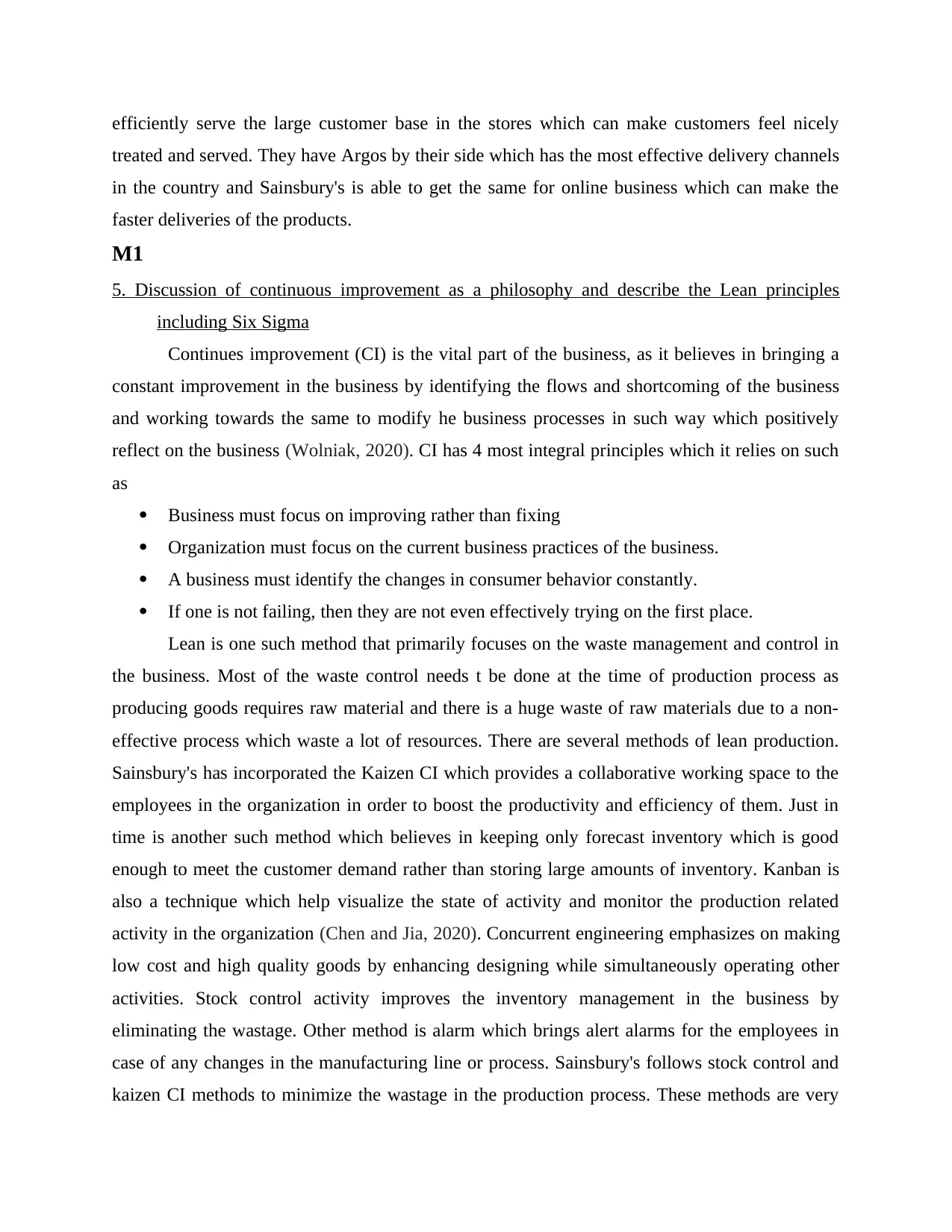
efficiently serve the large customer base in the stores which can make customers feel nicely
treated and served. They have Argos by their side which has the most effective delivery channels
in the country and Sainsbury's is able to get the same for online business which can make the
faster deliveries of the products.
M1
5. Discussion of continuous improvement as a philosophy and describe the Lean principles
including Six Sigma
Continues improvement (CI) is the vital part of the business, as it believes in bringing a
constant improvement in the business by identifying the flows and shortcoming of the business
and working towards the same to modify he business processes in such way which positively
reflect on the business (Wolniak, 2020). CI has 4 most integral principles which it relies on such
as
Business must focus on improving rather than fixing
Organization must focus on the current business practices of the business.
A business must identify the changes in consumer behavior constantly.
If one is not failing, then they are not even effectively trying on the first place.
Lean is one such method that primarily focuses on the waste management and control in
the business. Most of the waste control needs t be done at the time of production process as
producing goods requires raw material and there is a huge waste of raw materials due to a non-
effective process which waste a lot of resources. There are several methods of lean production.
Sainsbury's has incorporated the Kaizen CI which provides a collaborative working space to the
employees in the organization in order to boost the productivity and efficiency of them. Just in
time is another such method which believes in keeping only forecast inventory which is good
enough to meet the customer demand rather than storing large amounts of inventory. Kanban is
also a technique which help visualize the state of activity and monitor the production related
activity in the organization (Chen and Jia, 2020). Concurrent engineering emphasizes on making
low cost and high quality goods by enhancing designing while simultaneously operating other
activities. Stock control activity improves the inventory management in the business by
eliminating the wastage. Other method is alarm which brings alert alarms for the employees in
case of any changes in the manufacturing line or process. Sainsbury's follows stock control and
kaizen CI methods to minimize the wastage in the production process. These methods are very
treated and served. They have Argos by their side which has the most effective delivery channels
in the country and Sainsbury's is able to get the same for online business which can make the
faster deliveries of the products.
M1
5. Discussion of continuous improvement as a philosophy and describe the Lean principles
including Six Sigma
Continues improvement (CI) is the vital part of the business, as it believes in bringing a
constant improvement in the business by identifying the flows and shortcoming of the business
and working towards the same to modify he business processes in such way which positively
reflect on the business (Wolniak, 2020). CI has 4 most integral principles which it relies on such
as
Business must focus on improving rather than fixing
Organization must focus on the current business practices of the business.
A business must identify the changes in consumer behavior constantly.
If one is not failing, then they are not even effectively trying on the first place.
Lean is one such method that primarily focuses on the waste management and control in
the business. Most of the waste control needs t be done at the time of production process as
producing goods requires raw material and there is a huge waste of raw materials due to a non-
effective process which waste a lot of resources. There are several methods of lean production.
Sainsbury's has incorporated the Kaizen CI which provides a collaborative working space to the
employees in the organization in order to boost the productivity and efficiency of them. Just in
time is another such method which believes in keeping only forecast inventory which is good
enough to meet the customer demand rather than storing large amounts of inventory. Kanban is
also a technique which help visualize the state of activity and monitor the production related
activity in the organization (Chen and Jia, 2020). Concurrent engineering emphasizes on making
low cost and high quality goods by enhancing designing while simultaneously operating other
activities. Stock control activity improves the inventory management in the business by
eliminating the wastage. Other method is alarm which brings alert alarms for the employees in
case of any changes in the manufacturing line or process. Sainsbury's follows stock control and
kaizen CI methods to minimize the wastage in the production process. These methods are very
⊘ This is a preview!⊘
Do you want full access?
Subscribe today to unlock all pages.

Trusted by 1+ million students worldwide

effective as they are helping in meeting the goals of the organization by availing sainsvbury's
wastage reduction in production and inventory management.
Six sigma model techniques helps in improving the process on the organization. There
are three principles which avails the framework which reduces the flaws' ad defects. Sainsbury's
utilizes this model to deliver the best customer satisfaction. Under this first principles if to
understand the customers taste, preference, expectations and fulfilling the same. Second is the
elimination of the wastage to minimizes the deviations I will enable better customer experience
due to standardization. Last principle states that an effective communication must be maintained
which tales inputs from customers. It is a very suitable method for Sainsbury's as it will make
organization very customer oriented and flexible enough to adapt the changes (Zhang, Wang and
Lin, 2019).
P2
Prepare a continuous improvement plan based on the review and critique of operations
management principles within an organizational context
To analyze the Sainsbury's continues improvement plan (CI) there will be using several
models while determining the demerits and merits of the company.
Kaizen: Sainsbury's incorporates collaborative working style to adapt changes effectively.
Advantage is the creation of a better working environment which enhances productivity and
disadvantage is the team members lack of willingness to cooperate for the team work.
Quality circles: it believes in determining the potential hurdles and solving the same by focusing
on plan, do, act and check. Advantage is the improvement of individuals and disadvantage he
time required for making changes.
Bench marking: it avails the setting of some standards against which the business performance
can be measured for Sainsbury's with the Tesco and Morison. Benefit is the improvement in
processes yet the drawbacks is the lack of customer retention (Bazmohammadi and et.al., 2018).
TQM: it helps in achieving the organizational goals by improving the quality of the products and
services. Advantage is the ability attract customer with high quality products and disadvantage is
that this method is not a quick fix of the organizational problems.
SCM: supply chain management is val as it avails the effective flow goods in the market place.
Benefits is the ability to meet the demand on time and disadvantage is inventory management
cost associated with it.
wastage reduction in production and inventory management.
Six sigma model techniques helps in improving the process on the organization. There
are three principles which avails the framework which reduces the flaws' ad defects. Sainsbury's
utilizes this model to deliver the best customer satisfaction. Under this first principles if to
understand the customers taste, preference, expectations and fulfilling the same. Second is the
elimination of the wastage to minimizes the deviations I will enable better customer experience
due to standardization. Last principle states that an effective communication must be maintained
which tales inputs from customers. It is a very suitable method for Sainsbury's as it will make
organization very customer oriented and flexible enough to adapt the changes (Zhang, Wang and
Lin, 2019).
P2
Prepare a continuous improvement plan based on the review and critique of operations
management principles within an organizational context
To analyze the Sainsbury's continues improvement plan (CI) there will be using several
models while determining the demerits and merits of the company.
Kaizen: Sainsbury's incorporates collaborative working style to adapt changes effectively.
Advantage is the creation of a better working environment which enhances productivity and
disadvantage is the team members lack of willingness to cooperate for the team work.
Quality circles: it believes in determining the potential hurdles and solving the same by focusing
on plan, do, act and check. Advantage is the improvement of individuals and disadvantage he
time required for making changes.
Bench marking: it avails the setting of some standards against which the business performance
can be measured for Sainsbury's with the Tesco and Morison. Benefit is the improvement in
processes yet the drawbacks is the lack of customer retention (Bazmohammadi and et.al., 2018).
TQM: it helps in achieving the organizational goals by improving the quality of the products and
services. Advantage is the ability attract customer with high quality products and disadvantage is
that this method is not a quick fix of the organizational problems.
SCM: supply chain management is val as it avails the effective flow goods in the market place.
Benefits is the ability to meet the demand on time and disadvantage is inventory management
cost associated with it.
Paraphrase This Document
Need a fresh take? Get an instant paraphrase of this document with our AI Paraphraser
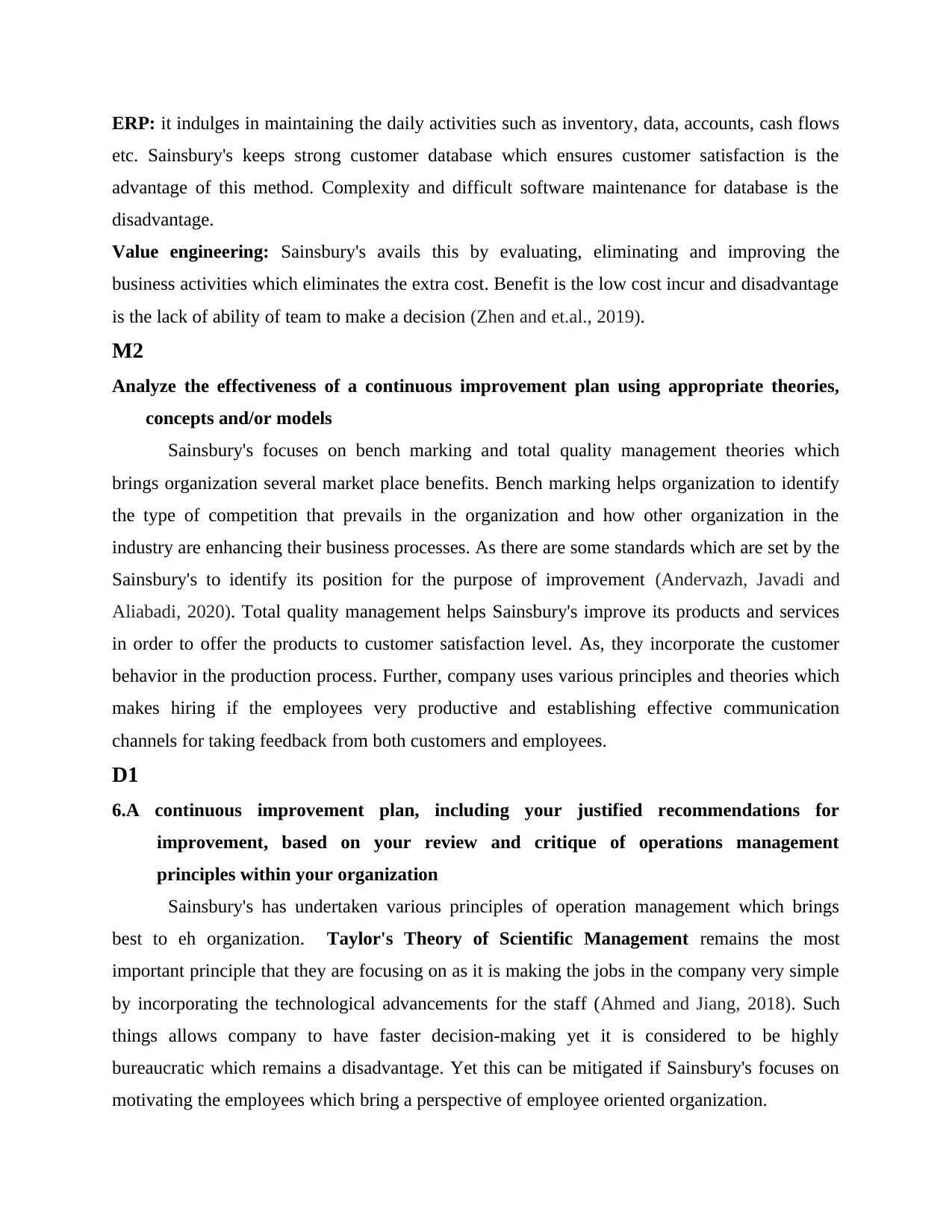
ERP: it indulges in maintaining the daily activities such as inventory, data, accounts, cash flows
etc. Sainsbury's keeps strong customer database which ensures customer satisfaction is the
advantage of this method. Complexity and difficult software maintenance for database is the
disadvantage.
Value engineering: Sainsbury's avails this by evaluating, eliminating and improving the
business activities which eliminates the extra cost. Benefit is the low cost incur and disadvantage
is the lack of ability of team to make a decision (Zhen and et.al., 2019).
M2
Analyze the effectiveness of a continuous improvement plan using appropriate theories,
concepts and/or models
Sainsbury's focuses on bench marking and total quality management theories which
brings organization several market place benefits. Bench marking helps organization to identify
the type of competition that prevails in the organization and how other organization in the
industry are enhancing their business processes. As there are some standards which are set by the
Sainsbury's to identify its position for the purpose of improvement (Andervazh, Javadi and
Aliabadi, 2020). Total quality management helps Sainsbury's improve its products and services
in order to offer the products to customer satisfaction level. As, they incorporate the customer
behavior in the production process. Further, company uses various principles and theories which
makes hiring if the employees very productive and establishing effective communication
channels for taking feedback from both customers and employees.
D1
6.A continuous improvement plan, including your justified recommendations for
improvement, based on your review and critique of operations management
principles within your organization
Sainsbury's has undertaken various principles of operation management which brings
best to eh organization. Taylor's Theory of Scientific Management remains the most
important principle that they are focusing on as it is making the jobs in the company very simple
by incorporating the technological advancements for the staff (Ahmed and Jiang, 2018). Such
things allows company to have faster decision-making yet it is considered to be highly
bureaucratic which remains a disadvantage. Yet this can be mitigated if Sainsbury's focuses on
motivating the employees which bring a perspective of employee oriented organization.
etc. Sainsbury's keeps strong customer database which ensures customer satisfaction is the
advantage of this method. Complexity and difficult software maintenance for database is the
disadvantage.
Value engineering: Sainsbury's avails this by evaluating, eliminating and improving the
business activities which eliminates the extra cost. Benefit is the low cost incur and disadvantage
is the lack of ability of team to make a decision (Zhen and et.al., 2019).
M2
Analyze the effectiveness of a continuous improvement plan using appropriate theories,
concepts and/or models
Sainsbury's focuses on bench marking and total quality management theories which
brings organization several market place benefits. Bench marking helps organization to identify
the type of competition that prevails in the organization and how other organization in the
industry are enhancing their business processes. As there are some standards which are set by the
Sainsbury's to identify its position for the purpose of improvement (Andervazh, Javadi and
Aliabadi, 2020). Total quality management helps Sainsbury's improve its products and services
in order to offer the products to customer satisfaction level. As, they incorporate the customer
behavior in the production process. Further, company uses various principles and theories which
makes hiring if the employees very productive and establishing effective communication
channels for taking feedback from both customers and employees.
D1
6.A continuous improvement plan, including your justified recommendations for
improvement, based on your review and critique of operations management
principles within your organization
Sainsbury's has undertaken various principles of operation management which brings
best to eh organization. Taylor's Theory of Scientific Management remains the most
important principle that they are focusing on as it is making the jobs in the company very simple
by incorporating the technological advancements for the staff (Ahmed and Jiang, 2018). Such
things allows company to have faster decision-making yet it is considered to be highly
bureaucratic which remains a disadvantage. Yet this can be mitigated if Sainsbury's focuses on
motivating the employees which bring a perspective of employee oriented organization.

Focusing on customer's wants and expectation from the brand and delivering the same.
Eliminating any such process which is leading to the waste of resources has decreased the cost.
Customization of goods and services had further enhanced the premium products' sale even with
high prices of products. Disadvantage is the typical supply chain dealing which is very hectic.
Sainsbury's should focus on choosing multiple platforms for advertising.
7. CONCLUSION
The report has stated the operation management of the Sainsbury's and made various
recommendation which are suitable for the business of the organization. Focusing on low cost ,
high quality, multimedia channel, effective supply chain management, employee and customer
oriented affairs can improve the overall business operations which has the capability to increase
the profitability of the company. Also, the continues improvement methodology can look for the
shortcoming in the operations and then create improvement for the same.
Eliminating any such process which is leading to the waste of resources has decreased the cost.
Customization of goods and services had further enhanced the premium products' sale even with
high prices of products. Disadvantage is the typical supply chain dealing which is very hectic.
Sainsbury's should focus on choosing multiple platforms for advertising.
7. CONCLUSION
The report has stated the operation management of the Sainsbury's and made various
recommendation which are suitable for the business of the organization. Focusing on low cost ,
high quality, multimedia channel, effective supply chain management, employee and customer
oriented affairs can improve the overall business operations which has the capability to increase
the profitability of the company. Also, the continues improvement methodology can look for the
shortcoming in the operations and then create improvement for the same.
⊘ This is a preview!⊘
Do you want full access?
Subscribe today to unlock all pages.

Trusted by 1+ million students worldwide
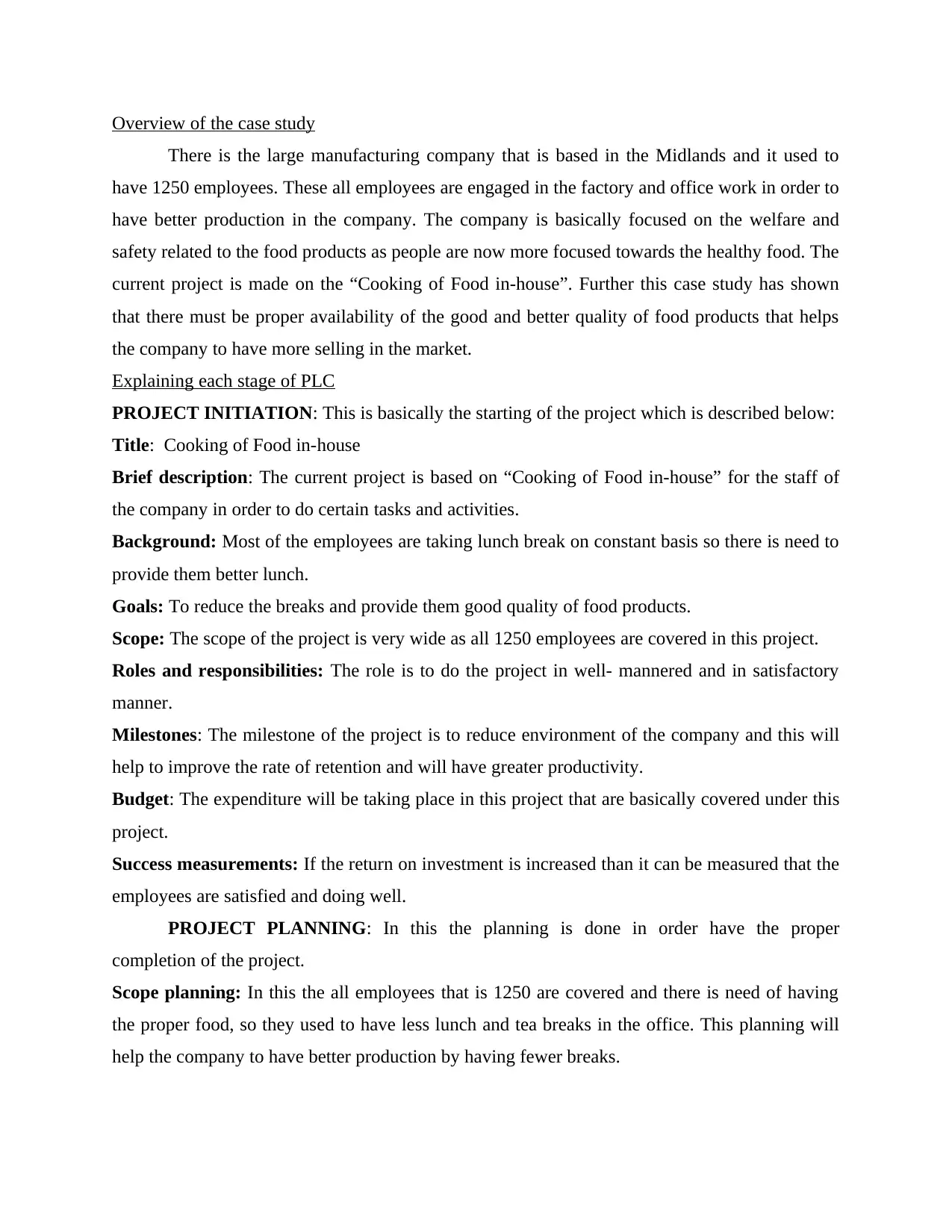
Overview of the case study
There is the large manufacturing company that is based in the Midlands and it used to
have 1250 employees. These all employees are engaged in the factory and office work in order to
have better production in the company. The company is basically focused on the welfare and
safety related to the food products as people are now more focused towards the healthy food. The
current project is made on the “Cooking of Food in-house”. Further this case study has shown
that there must be proper availability of the good and better quality of food products that helps
the company to have more selling in the market.
Explaining each stage of PLC
PROJECT INITIATION: This is basically the starting of the project which is described below:
Title: Cooking of Food in-house
Brief description: The current project is based on “Cooking of Food in-house” for the staff of
the company in order to do certain tasks and activities.
Background: Most of the employees are taking lunch break on constant basis so there is need to
provide them better lunch.
Goals: To reduce the breaks and provide them good quality of food products.
Scope: The scope of the project is very wide as all 1250 employees are covered in this project.
Roles and responsibilities: The role is to do the project in well- mannered and in satisfactory
manner.
Milestones: The milestone of the project is to reduce environment of the company and this will
help to improve the rate of retention and will have greater productivity.
Budget: The expenditure will be taking place in this project that are basically covered under this
project.
Success measurements: If the return on investment is increased than it can be measured that the
employees are satisfied and doing well.
PROJECT PLANNING: In this the planning is done in order have the proper
completion of the project.
Scope planning: In this the all employees that is 1250 are covered and there is need of having
the proper food, so they used to have less lunch and tea breaks in the office. This planning will
help the company to have better production by having fewer breaks.
There is the large manufacturing company that is based in the Midlands and it used to
have 1250 employees. These all employees are engaged in the factory and office work in order to
have better production in the company. The company is basically focused on the welfare and
safety related to the food products as people are now more focused towards the healthy food. The
current project is made on the “Cooking of Food in-house”. Further this case study has shown
that there must be proper availability of the good and better quality of food products that helps
the company to have more selling in the market.
Explaining each stage of PLC
PROJECT INITIATION: This is basically the starting of the project which is described below:
Title: Cooking of Food in-house
Brief description: The current project is based on “Cooking of Food in-house” for the staff of
the company in order to do certain tasks and activities.
Background: Most of the employees are taking lunch break on constant basis so there is need to
provide them better lunch.
Goals: To reduce the breaks and provide them good quality of food products.
Scope: The scope of the project is very wide as all 1250 employees are covered in this project.
Roles and responsibilities: The role is to do the project in well- mannered and in satisfactory
manner.
Milestones: The milestone of the project is to reduce environment of the company and this will
help to improve the rate of retention and will have greater productivity.
Budget: The expenditure will be taking place in this project that are basically covered under this
project.
Success measurements: If the return on investment is increased than it can be measured that the
employees are satisfied and doing well.
PROJECT PLANNING: In this the planning is done in order have the proper
completion of the project.
Scope planning: In this the all employees that is 1250 are covered and there is need of having
the proper food, so they used to have less lunch and tea breaks in the office. This planning will
help the company to have better production by having fewer breaks.
Paraphrase This Document
Need a fresh take? Get an instant paraphrase of this document with our AI Paraphraser

Preparation of the work breakdown structure: This is basically divided in to the four main task
that is described below:
Project schedule development: The project need to be completed in the decided time
frame that helps the project to be completed on time. The current project is based on the financial
year in which all the activities of the project will be done by using the Gantt Chart by
considering the days required in the project (Rezaei Kalvani, Sharaai and Abdullahi, 2021).
PERFORMER TASK SPECIALIZATION
Project experts are required. Planning of the tasks. Project management.
Budget manager. Planning of expenditure
(Kühnen and Hahn, 2018.).
Basic knowledge about
finance.
Executor of the project. Execution of project. Project management.
that is described below:
Project schedule development: The project need to be completed in the decided time
frame that helps the project to be completed on time. The current project is based on the financial
year in which all the activities of the project will be done by using the Gantt Chart by
considering the days required in the project (Rezaei Kalvani, Sharaai and Abdullahi, 2021).
PERFORMER TASK SPECIALIZATION
Project experts are required. Planning of the tasks. Project management.
Budget manager. Planning of expenditure
(Kühnen and Hahn, 2018.).
Basic knowledge about
finance.
Executor of the project. Execution of project. Project management.
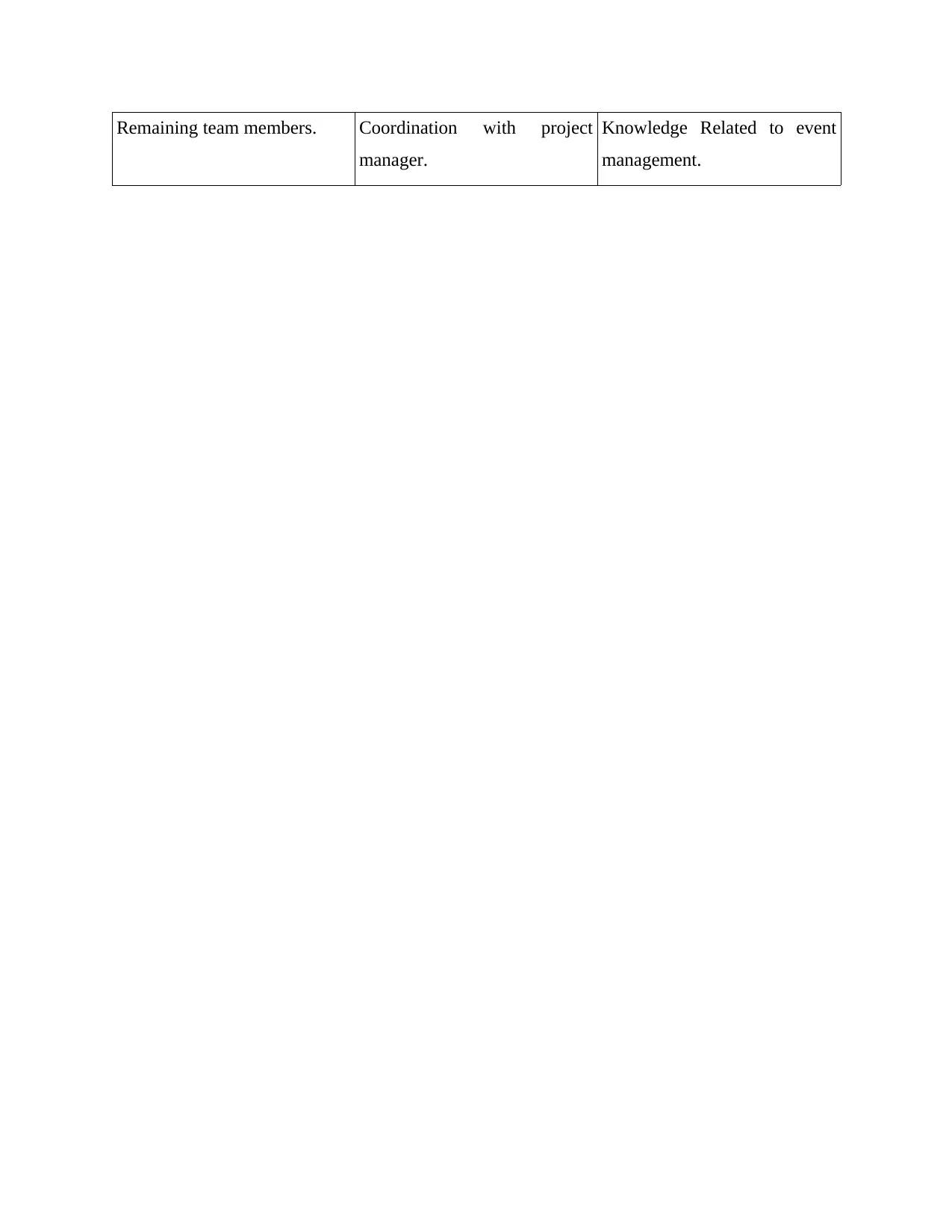
Remaining team members. Coordination with project
manager.
Knowledge Related to event
management.
manager.
Knowledge Related to event
management.
⊘ This is a preview!⊘
Do you want full access?
Subscribe today to unlock all pages.

Trusted by 1+ million students worldwide
1 out of 20
Related Documents
Your All-in-One AI-Powered Toolkit for Academic Success.
+13062052269
info@desklib.com
Available 24*7 on WhatsApp / Email
![[object Object]](/_next/static/media/star-bottom.7253800d.svg)
Unlock your academic potential
Copyright © 2020–2025 A2Z Services. All Rights Reserved. Developed and managed by ZUCOL.




